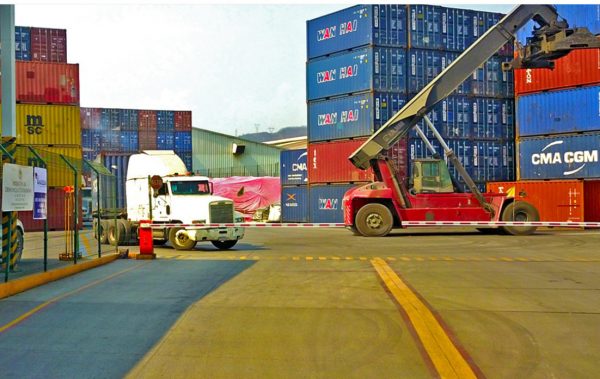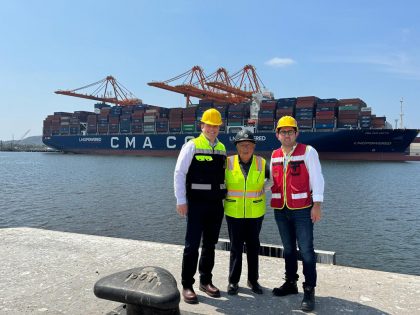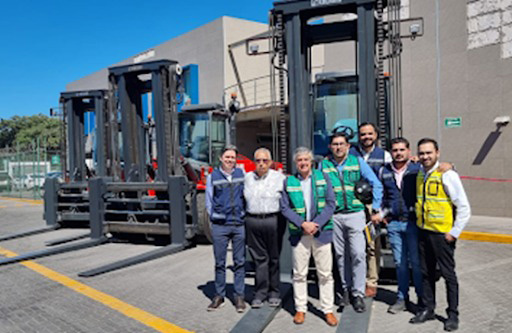 From that distant May 18, 1990, when three friends partnered to found the company Hazesa, whose role was cargo transportation, to the present, where the group has become a key player in the economy of the State of Colima. They have consolidated a modern general cargo terminal in Manzanillo, logistics warehouses, and a truck fleet that distributes goods throughout Mexico.
From that distant May 18, 1990, when three friends partnered to found the company Hazesa, whose role was cargo transportation, to the present, where the group has become a key player in the economy of the State of Colima. They have consolidated a modern general cargo terminal in Manzanillo, logistics warehouses, and a truck fleet that distributes goods throughout Mexico.
Raúl Sandoval Calderón, one of the three visionaries who started what today is Grupo Hazesa, tells how it has been guiding a company for 33 years, reviewing all those foundational milestones that made it what it is today.
Sandoval recalls that the company’s beginnings were not directly linked to water but inland, in logistics.
“The link was not immediate because Hazesa began as a small transportation company. Like many others, we carried cargo through federal routes. As time went by, the fleet grew larger, thanks to the efforts of our collaborators,” he says.
“Our start with logistics, associated with the port, began after the earthquake of October 1995, which had its epicenter in our state of Colima and destroyed part of the infrastructure of the port of Manzanillo. That damage resulted in a series of problems for shipping lines when removing their containers from the port. In this way, the idea of having esplanades for storing empty containers outside the terminal quickly germinated,” he adds.

Hazesa’s effort and service quality caught Maersk’s eye, and it immediately recognized it as a potential partner for its inland operations. Thus, Hazesa began its journey to the sea.
“The first to contact Hazesa to implement an off-site container depot was Maersk. The Danish shipping company gave us the confidence to start this new line of business with a major client. The invitation from this logistics giant was an enormous challenge that we faced with great professional rigor, and shortly after the start of our yard operations, other lines began to arrive, such as Sudamericana de Vapores, NYK, Sea Land, Maruba, just to name a few,” recalls Sandoval.
“The empty container yard advanced very successfully, and its role energized the port business, helping shipping companies to optimize their logistics processes. The alliance with Maersk was consolidated, and thanks to that, Hazesa and they formed a partnership where I was appointed director, and I was in charge of helping with the delivery, reception, cleaning, and repair of containers. At the same time, our fleet of trucks increased, thanks to the acquisition of new units, but also to the formation of a community where we had the cargo and subcontracted transport services to other machine owners who were available to work under the quality standard that was already a hallmark of our company”, he recalls.

The alliance with Maersk meant taking steps toward the sea, but first, the company continued to strengthen its business model. Then, hand in hand with a new ally, it moved even closer to port operations.
“Twenty years ago, Maersk decided to move its dock operations from Manzanillo to the Port of Lázaro Cárdenas in the State of Michoacán and invited us to join them as logistics partners. We did this for a couple of years until we decided to change our business model there and ended up leasing our infrastructure instead of operating it directly,” he explains.
The step before operating a dock involved storing minerals for Grupo Mexico. The operation allowed Hazesa to learn the port dynamics and the different types of mineral bulk in detail.
“To discuss that, I must mention Grupo Mexico, who asked us to store many minerals that were delivered to them in our warehouse but were delivered to transnational companies engaged in the marketing of commodities,” says Raul Sandoval.
“Thanks to this virtuous alliance, materials from the mines began to arrive all over Mexico, and we mixed them, conditioned them, and finally had to ship them through the port. This new expansion of Hazesa allowed us to learn in detail the processes to make them more efficient and environmentally friendly. All this experience was the prelude to participating in the bidding process for the awarding of the construction and subsequent operation of the Manzanillo terminal, which happened in 2012 when we made the most competitive offer compared to the Spanish consortium with which we reached the final”, he adds.
Although Hazesa started in the 1990s, Raul says that his and his family’s presence dates back to 1975. Their honesty and willingness to learn have always been hallmarks, allowing them to adapt to all undertakings.
“We arrived in Manzanillo in 1975. From that moment on, our hallmark has been hard work and commitment to each of our clients over the years. These values were handed down to us in our parents’ family: honesty and willingness to learn new things were the key to cementing Hazesa’s reputation as a reliable partner for more and more logistics operations, whether land or sea,” he says.
The group consolidated fully in 2015-2016 when it opened the bulk terminal in the Port of Manzanillo, one of the most important in Mexico due to its maritime connections, cargo volumes, competition, and geographical location. This milestone has been a source of pride for Raúl Sandoval, involving years of work and overcoming countless obstacles.
“I am proud to have transformed the efficiency of the ship loading system, which translates into dock stays that went from 4 or 5 days to just a few hours. By 2023, we estimate we will reach 2.5 million tons transferred at our terminal”, he says.
In this stage of Hazesa’s venture, Kalmar and Sitsa have played – in Raúl Sandoval’s own words – an efficient and resilient partner.
“If we are efficient, it is not only because of the service vocation of the human team of the organization I lead but also because we acquire resistant equipment that ensures the best performance: that is how we came to the Finnish brand Kalmar. The Kalmar reach stacker has given us excellent results in our operations. We have also had good results with the 6 large forklifts, with a lifting capacity of 25 to 30 tons,” he says.
“Being Manzanillo, a consumer of Kalmar machinery, with already such good results, complemented by the proximity of other terminals, I would like to thank their representatives in Mexico, SITSA, who are always concerned that we, their customers, are satisfied. We have a complete warehouse of parts and spare parts a few hours’ flight from Manzanillo, so the maintenance is done with planning, which allows us to have everything we need on time. When imponderables arise, the executives of Kalmar and SITSA can always solve them quickly. I have no doubt that we owe part of Hazesa’s success to our robust and reliable Kalmar equipment”, says Raúl Sandoval.







